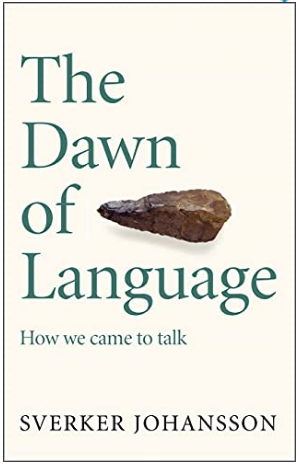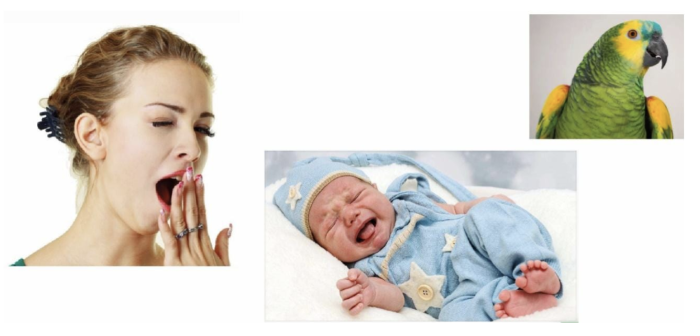Did the ability to lie boost the evolution of the human race?
fev 28 2023By Marcos Chiquetto

I just finished reading the book “The Dawn of Language” by Sverker Johansson. It is a general survey of the current state of study related to the emergence of human language.

In his work, the author explains that in order to develop a research study in this field, one must first answer the basic question: what is language?
In his work, the author explains that in order to develop a research study in this field, one must first answer the basic question: what is language?
Let’s look at a few examples that show how complex this question really is:
- When a person yawns, they are sending a message that is received by anyone in close proximity. Do these kinds of messages constitute language? Could there be a “yawn language”?
- And when babies cry? Is this language? Could there be an “infant crying language”?
- And when parrots talk? Could this be considered a language?

Evidently, people are free to adopt whatever criteria they desire, and may include yawns, cries or parrot speech in their categorization of language if they want to. The problem is that, if many different people are conducting scientific research studies on language, it would be advisable for everyone to use the same criteria to define the object of their study, so that their results can be compared.
According to Johansson, in the decade of the 1960s the linguist Charles Hockett proposed a list of criteria for deciding whether a determined set of messages is a human language. A set of messages is a human language if:
- The communication occurs through the use of voice and hearing.
- The transmission is not targeted (anyone nearby can hear) but reception is targeted (the listener can always identify who is speaking).
- The signal (in this case, the speech) disappears immediately after it is issued.
- Anything that can be heard can also be spoken by the listener.
- The speaker can always hear his or her own messages.
- The communication is always intentional.
- Each signal is specifically connected to a particular meaning.
- The signals are random, that is, there is no specific rule for attributing meaning to the signals.
- The set of messages is constructed from smaller elements that function like bricks. For example, phonemes forming words and words forming sentences.
- The communication can refer to things that are not present at the time of the communication (this is the only one can tell a story).
- Languages can be learned and passed along within a social group. Children can learn a language from adults.
- You cannot always believe a message. When using a language, it is possible to lie.
- A language may be used to communicate about the language itself.
Nowadays, there is a lot of criticism of these criteria. They do not include, for example, sign language used by the deaf, which does not comply with the first criteria. Today, therefore, this list, created in the decade of the 1960s, will certainly have to be revised. But it had an important role in the development of research in the area of languages.
Let´s use these criteria to answer the questions we posed at the beginning of this article:
- Yawns clearly don’t meet criteria number 6, because yawns are not intentional. Therefore, there is no “yawn language.”
- The crying of babies certainly doesn’t satisfy criteria 4, because a mother cannot cry like her child, despite the fact that she receives the message from her child. Thus, the crying of babies is not considered to be a language. There is no “crying language.”
- Adult parrots do not teach their baby parrots to speak, therefore, the speech of parrots doesn’t meet criteria 11, and as a result, does not constitute a language.
I found these criteria to be very interesting. They reflect the need of that researcher, at that moment, to delineate his field of research. The criteria were undoubtedly created to eliminate types of communication that he didn’t want to study, as in the case of the three examples above.
But what intrigued me the most in this list was criteria 12. A set of messages can only be considered a language, according to Hockett, if it allows for the emission of communication that may not be truthful. In other words, it is possible to use these messages to lie. I can’t imagine what messages he was trying to exclude from his classification when he established this criteria, but, certainly, all of the human languages that I’m familiar with pass this test. You can lie in any language.

Johansson presents, then, a fascinating thesis: as they developed languages, human beings had to strengthen their emotional ties and their attempts to collaborate with other humans, since they could never totally trust what others were saying due to the fact that any of them could lie if they wanted to. And this collaboration and these emotional ties were determining factors in the evolution of our species.

That is something quite complex, which is worth some deep reflection!
Reference: Johansson, Sverker. The Dawn of Language: The story of how we came to talk. Quercus. Kindle Edition.

Marcos Chiquetto is an engineer, Physics teacher, translator, and writer. He is the director of LatinLanguages, a Brazilian translation agency specialized in providing multilingual companies with translation into Portuguese and Spanish.




